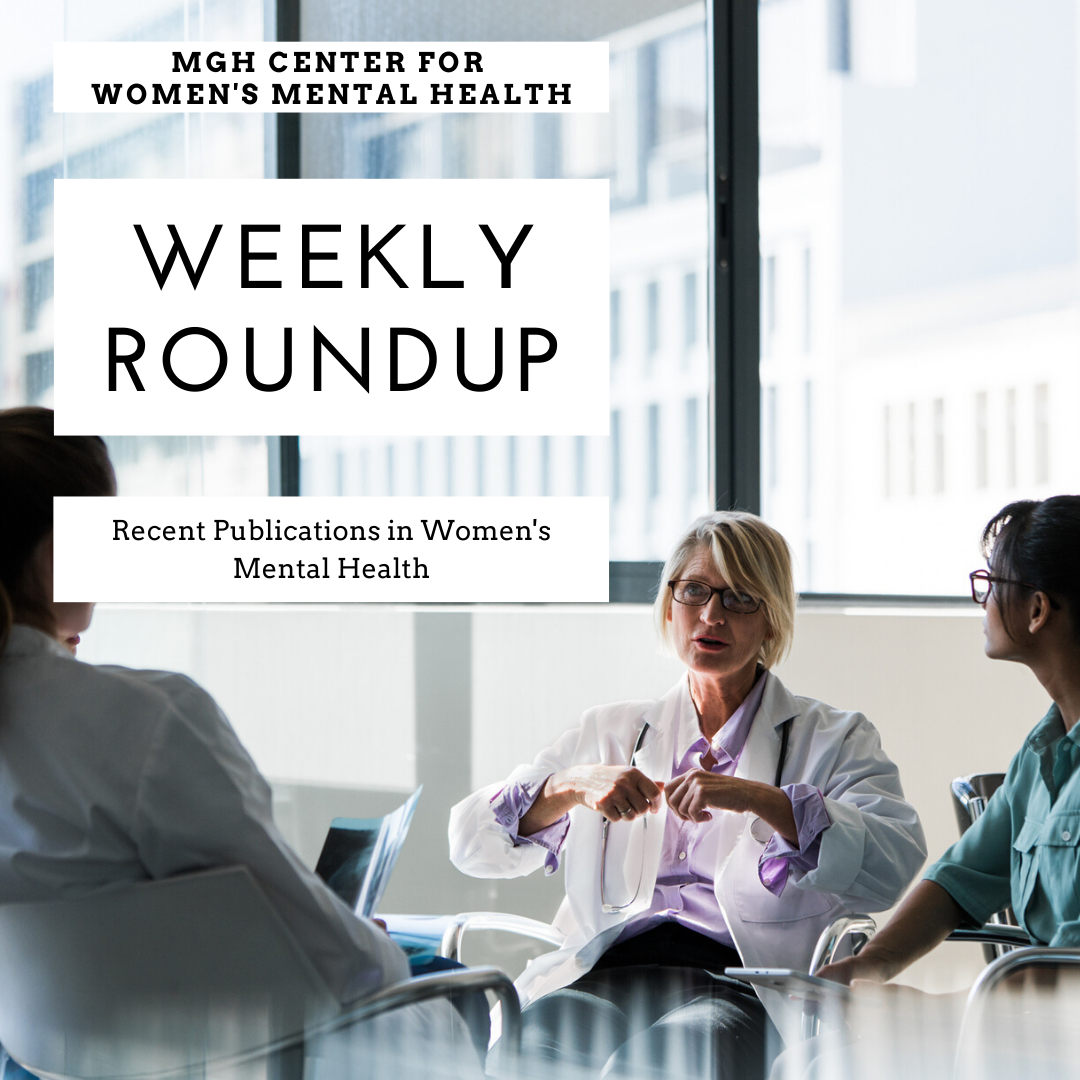
Every week we review the most recent publications in women’s mental health, covering topics related to premenstrual symptoms, perinatal mood and anxiety disorders, use of medications in pregnant and breastfeeding women, perinatal substance use, and menopausal mental health.
Maybe I was in a particularly good mood when I put together this list, but there are so many good articles to read this week!
Two articles look at the role of poor sleep in perinatal women. A meta-analysis from Pangini and colleagues demonstrates a more than threefold increase in risk for suicidal ideation in women reporting insomnia and poor sleep. A review from Sharma and colleagues suggests that more aggressive management of sleep disturbance may also be a means of reducing risk of postpartum depression.
Several studies look at ketamine administered at delivery as a means of managing pain and reducing risk for postpartum depression.
For policy makers, there is a nice review documenting the beneficial effects of paid maternity leave in terms of reducing risk of postpartum depression. No surprise, but it is good to have solid data when advocating for change.
For more detailed descriptions of many of these topics, you can sign up to receive our weekly CWMH NEWSLETTER which comes out every Thursday.
Ruta Nonacs, MD PhD
PMS AND PMDD |
| No articles this week |
INFERTILITY AND MENTAL HEALTH |
| No articles this week |
PSYCHIATRIC ILLNESS DURING PREGNANCY |
| Self-harm in pregnancy and the postnatal year: prevalence and risk factors.
Ayre K, Liu X, Howard LM, Dutta R, Munk-Olsen T. Psychol Med. 2023 May;53(7):2895-2903. Prevalence rates of self-harm in pregnancy were 32.2 per 100 000 deliveries and, postnatally, 63.3 per 100 000 deliveries. Risk factors for perinatal self-harm: younger age, non-Danish birth, prior self-harm, psychiatric history and parental psychiatric history. Additional risk factors for postpartum self-harm: multiparity and preterm birth. Of psychiatric conditions, personality disorder was most strongly associated with self-harm during pregnancy (aHR 3.15, 95% CI 1.68-5.89); psychosis was most strongly associated with postpartum self-harm (aHR 6.36, 95% CI 4.30-9.41). |
| Positive affect improves a transdiagnostic model of perinatal depression symptoms.
Pingeton BC, Cochran A, Goodman SH, Laurent H, Sbrilli MD, Knight B, Newport DJ, Stowe ZN. J Affect Disord. 2023 Sep 1;336:112-119. |
| Scoping Review of the Use of the Edinburgh Postnatal Depression Scale in the United States.
Moyer SW, Brown R, Jallo N, Kinser PA. J Womens Health (Larchmt). 2023 Jul;32(7):767-778. |
| Associations between Adverse Childhood Experiences (ACEs) and Prenatal Mental Health and Substance Use.
Foti TR, Watson C, Adams SR, Rios N, Staunton M, Wei J, Sterling SA, Ridout KK, Young-Wolff KC. Int J Environ Res Public Health. 2023 Jul 4;20(13):6289. Patients with 1-2 ACEs or ?3 ACEs (versus 0 ACEs) had higher odds of anxiety and depressive disorders, depressive symptoms, IPV, and any prenatal substance use (OR 1.44-4.40, p < 0.05). |
| Effectiveness of digital psychological interventions in reducing perinatal depression: a systematic review of meta-analyses.
Chen C, Wang X, Xu H, Li Y. Arch Womens Ment Health. 2023 Aug;26(4):423-439. Digital psychological interventions are effective in reducing perinatal depression, but the methodological quality and reliability of outcome indicators are mostly low. |
MEDICATIONS AND PREGNANCY |
| In utero exposure to ADHD medication and long-term offspring outcomes.
Bang Madsen K, Robakis TK, Liu X, Momen N, Larsson H, Dreier JW, Kildegaard H, Groth JB, Newcorn JH, Hove Thomsen P, Munk-Olsen T, Bergink V. Mol Psychiatry. 2023 Apr;28(4):1739-1746. In total, 898 children were exposed to ADHD medication during pregnancy compared to 1270 children whose mothers discontinued ADHD medication before pregnancy. After adjustment for demographic and psychiatric characteristics of the mother, no increased risk of any offspring developmental disorders was found combined (aHR 0.97, 95% CI 0.81 to 1.17) or for separate subcategories. Similarly, no increased risk was found for any sub-categories of outcomes in the negative control or sibling controlled analyses. Neurodevelopment and growth in offspring do not differ based on antenatal exposure to ADHD medication. |
| Ascertainment of malformations in pregnancy registries: Lessons learned in the North American AED Pregnancy Registry.
Holmes LB, Quinn M, Conant S, Lyons A, Hauser WA, Yerby M, Hernandez-Diaz S. Birth Defects Res. 2023 Jun 30. The NAAPR enrolls pregnant women who are taking one or more AEDs for any medical condition, but primarily to prevent seizures, and an unexposed comparison group. Participants are interviewed by clinical research coordinators (CRCs) at enrollment, later in pregnancy and postpartum. Malformations are identified in the mother’s reports and her infant’s medical records through age 12 weeks. A teratologist, blinded to exposure status, evaluates each potential malformation identified. |
| Fetal SSRI antidepressant exposure and infant sleep: Findings from the MPEWS pregnancy cohort study.
Galbally M, Watson SJ, Nguyen T, Boyce P.Infant Behav Dev. 2023 Jun 28;72:101849. Use of antidepressants sertraline, escitalopram and citalopram during pregnancy were not associated with increased infant waking or time awake. However, sertraline was associated with longer time for an infant to go to sleep. |
POSTPARTUM PSYCHIATRIC ILLNESS |
| Depression and anxiety disorders during the postpartum period in women diagnosed with attention deficit hyperactivity disorder.
Andersson A, Garcia-Argibay M, Viktorin A, Ghirardi L, Butwicka A, Skoglund C, Bang Madsen K, D’onofrio BM, Lichtenstein P, Tuvblad C, Larsson H. J Affect Disord. 2023 Mar 15;325:817-823. A total of 16.76 % of the women with an ADHD diagnosis were also diagnosed with depression disorders in the postpartum period, prevalence ratio (PR) 5.09 (95 % confidence interval (CI), 4.68-5.54). A total of 24.92 % of the women with an ADHD diagnosis were also diagnosed with anxiety disorders in the postpartum period, PR 5.41 (5.06-5.78). |
| Validation of a Brief Measure for Complicated Grief Specific to Reproductive Loss.
Buskmiller C, Grauerholz KR, Bute J, Brann M, Fredenburg M, Refuerzo JS. Cureus. 2023 Apr 20;15(4):e37884. |
MEDICATIONS AND BREASTFEEDING |
| No articles this week |
PERINATAL SUBSTANCE USE |
| No articles this week |
MATERNAL MENTAL HEALTH AND CHILD OUTCOMES |
| Latent class analysis of maternal depression from pregnancy through early childhood: Differences in children’s executive functions.
Choe DE, Deer LK, Hastings PD. Dev Psychol. 2023 Aug;59(8):1452-1463. Children exposed to chronic maternal depression beginning in utero showed the most impairments in inhibitory control while accounting for child sex, verbal IQ, parents’ highest education level, and average family income in childhood. |
| Prenatal and Postnatal Maternal Depressive Symptoms Are Associated With White Matter Integrity in 5-Year-Olds in a Sex-Specific Manner.
Kumpulainen V, Copeland A, Pulli EP, Silver E, Kataja EL, Saukko E, Merisaari H, Lewis JD, Karlsson L, Karlsson H, Tuulari JJ. Biol Psychiatry. 2023 May 21:S0006-3223(23)01301-X. EPDS scores during the second trimester were positively associated with fractional anisotropy in boys after controlling for EPDS scores at 3 months postpartum. In contrast, postpartum EPDS scores at 3 months correlated negatively with fractional anisotropy in widespread areas only in girls after controlling for prenatal second-trimester EPDS scores. Perinatal anxiety was not associated with white matter structure. |
MENOPAUSE AND MENTAL HEALTH |
| No articles this week |
OTHER TOPICS IN WOMEN’S MENTAL HEALTH |
| No articles this week |



Leave A Comment